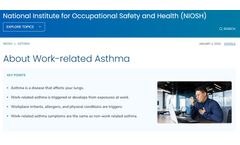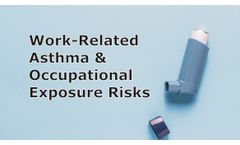Respiratory Irritants Articles & Analysis
47 news found
Symptoms can develop shortly after an exposure; however, they can also develop months or years after repeated exposures to harmful substances. Exposure to various irritants, allergens, and physical conditions could act as work-related asthma triggers. Some examples listed by NIOSH include: • Animal dander, insects, and dust mites • ...
In some asthmatics, aeroallergens could trigger an asthma attack, or potentially worsen other respiratory diseases. When dust is airborne, it can remain in the air for long periods of time and settle throughout an indoor space. ...
The month of May is dedicated to asthma control and education to increase awareness about the disease and how those with it can prevent or mitigate exposures to asthma triggers, allergens, and respiratory irritants. Asthma is one of the most common lifelong chronic diseases in Puerto Rico and across the rest of the United States, according to the Centers for ...
They offer testing for not only pet allergens, but also for dust mite, rodent, cockroach, mold, latex, and other allergens, respiratory irritants, and asthma triggers. They have even sponsored an educational video about pet allergens and indoor air quality that can be seen at: https://youtu.be/9pFX8IYAET4 To learn more about this or other indoor air quality, ...
Symptoms can develop shortly after an exposure; however, they can also develop months or years after repeated exposures to harmful substances. Exposure to various irritants, allergens, and physical conditions could act as work-related asthma triggers. Some examples listed by NIOSH include: • Animal dander, insects, and dust mites • ...
NIOSH warns that asthma symptoms can come and go, and some workers might not have all of the symptoms. Exposure to various irritants, allergens, and physical conditions could act as work-related asthma triggers. Some examples listed by NIOSH include: Animal dander, insects, and dust mites Chlorine-based cleaning products Cigarette smoke Materials from cockroaches Cold air Dust ...
We hope this new video helps to shed some light on the importance of protecting workers from exposure to allergens, respiratory irritants, and known asthma triggers.” This video was sponsored by a number of organizations and leading industry professionals that work to protect and enhance the public's health and safety. ...
This is due to the fact that breathing elevated levels of fungi can cause respiratory irritation, allergies, and act as an asthma trigger for some people with the condition. ...
They offer testing for not only pet allergens, but also for dust mite, rodent, cockroach, mold, latex and numerous other allergens, respiratory irritants and asthma triggers. They even recently sponsored an educational video about pet allergens and indoor air quality that can be seen at: https://youtu.be/9pFX8IYAET4 To learn more about Zimmetry Environmental ...
The Centers for Disease Control and Prevention (CDC) reports that almost 19% of children, and just over 25% of adults, have a seasonal allergy. These allergies can be a significant problem for some people, including during the hot summer months. High levels of airborne mold and pollen during the summer months can be an issue for people working or enjoying the outdoors. These same allergens and ...
Exposure to elevated levels of it, as with other types of fungi, may cause allergic reactions in some people or it can act as a respiratory irritant. Fusarium can even trigger an asthma attack in some people with the condition. ...
Like many other types of mold, Aspergillus can also act as an allergen, respiratory irritant and even an asthma trigger for some people.” Since airborne and settled Aspergillus is common across the globe at background concentrations in both indoor and outdoor environments, it takes an experienced industrial hygienist or infection control professional to ...
It’s also important to recognize that exposure to elevated levels of mold can act as a respiratory irritant, allergen and even trigger an asthma attack in some people with the condition, regardless of whether they have a suppressed or weakened immune ...
Exposure to elevated levels of fungi can also act as a respiratory irritant, allergen, or even an asthma trigger for some people with the condition. ...
Like other types of mold, Aspergillus can also act as an allergen, respiratory irritant and asthma trigger for some people.” Dedicated to identifying and mitigating indoor exposure risks to Aspergillus, and other microbial pathogens and contaminants, are the experts at Zimmetry. ...
While mold is a natural part of the environment, exposure to elevated levels of it in schools, work environments, and other places where people spend time can trigger asthma for some asthmatics, and cause various respiratory issues for others. The National Institute for Occupational Safety and Health (NIOSH) states that studies indicate that exposure to mold in the workplace can ...
While mold is a natural part of the environment, exposure to elevated levels of it in homes, schools, work environments and other places where people spend time can trigger asthma for some asthmatics, and cause various respiratory issues for others. The National Institute for Occupational Safety and Health (NIOSH) states that studies indicate exposure to mold in the workplace ...
Our experts also provide testing services for a wide range of other known asthma triggers, airborne allergens and respiratory irritants. If an issue is discovered, steps can then be implemented to eliminate or mitigate exposure ...
Chemical odors can frequently be the source of indoor environmental quality (IEQ) complaints. These odors may be from organic or inorganic compounds and exposure to some could be a health hazard, while others may not pose a risk. Odor complaints are frequently associated with volatile organic compounds (VOCs). VOCs are organic chemicals that easily evaporate into the air from liquids and some ...
The Centers for Disease Control and Prevention (CDC) reports that millions more suffer from the respiratory disease, but have not been diagnosed or treated. In Puerto Rico and throughout the rest of the country, exposure to tobacco smoke has long been known to be a key factor in the development and progression of COPD, but there are other exposure risks. ...




















